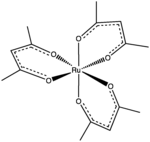乙酰丙酮钌
| 乙酰丙酮钌 | |
|---|---|

| |

| |
| IUPAC名 Tris(acetylacetonato)Ruthenium (III) | |
| 别名 | Ru(acac)3 乙酰丙酮钌(III) |
| 识别 | |
| CAS号 | 14284-93-6 |
| PubChem | 16057901 |
| SMILES |
|
| InChI |
|
| 性质 | |
| 化学式 | (C5H7O2)3Ru |
| 摩尔质量 | 398.39 g·mol⁻¹ |
| 外观 | 深紫色固体 |
| 密度 | 1.54 g/cm3[1] |
| 熔点 | 260 °C(533 K) |
| 溶解性(水) | 不溶 |
| 溶解性 | 可溶于大部分有机溶剂 |
| 危险性 | |
| 警示术语 | R:R36, R37, R38 |
| 安全术语 | S:S26, S36 |
| 若非注明,所有数据均出自标准状态(25 ℃,100 kPa)下。 | |
乙酰丙酮钌是一种乙酰丙酮配合物,化学式Ru(O2C5H7)3。它是一种深紫色固体,可溶于大多数有机溶剂。[2]它可用来制备其它钌化合物。
制备[编辑]
1914年,乙酰丙酮钌通过三氯化钌和乙酰丙酮在碳酸氢钾下的反应首次合成。[3]从那时起,人们已经研究了替代合成路线,但原始的制备方法仍然有用:[4]
- RuCl3•3H2O + MeCOCH2COMe → Ru(acac)3 + 3 HCl + 3 H2O
结构和性质[编辑]
乙酰丙酮钌有 D3 对称性。六个氧原子以八面体构型围绕钌原子。乙酰丙酮钌中的Ru-O 键长平均为 2.00 Å。[1]由于 Ru(acac)3 是低自旋的,有一个d 电子,所以是顺磁性的。Ru(acac)3 的磁化率 χM为 3.032×10−6 cm3/mol,有效磁矩 μeff为 1.66 μB。[5]在DMF溶液中,乙酰丙酮钌的氧化电位为 0.593,还原电位-1.223 V(相对于二茂铁/二茂铁阳离子对)。[6]
Ru(acac)3在烯烃存在下还原会形成二烯烃配合物。通常,此类反应是用锌在乙醇(1,3-二烯)[7]中或锌汞齐在潮湿的四氢呋喃中进行的:[8]
- 2 Ru(acac)3 + 4 alkene + Zn → 2 Ru(acac)2(alkene)2 + Zn(acac)2
产生的化合物是金属烯烃配合物的罕见例子,可以可逆地维持氧化:
- Ru(acac)2(alkene)2 ⇌ [Ru(acac)2(alkene)2]+ + e−
通过分离它和二苯甲酰基酒石酸的加合物,可拆分为单独的对映异构体。[9]
参考资料[编辑]
- ^ 1.0 1.1 Chao, G.; Sime, R. L.; Sime, R. J. Crystal and molecular structure of tris(acetylacetonato)ruthenium(III). Acta Crystallographica B. 1973, 29 (12): 2845. doi:10.1107/S0567740873007636.
- ^ R.C. Mehrotra, R. Bohra, and D.P. Gaur "Metal β-Diketonates and Allied Derivatives", 1st ed.; Academic Press inc.: New York, 1978. ISBN 0-12-488150-5.
- ^ Barbieri, G. A. Systematic chemical investigations: ruthenium, rhodium, palladium. Atti Accad, Lincei. 1914, 23 (1): 334–40.
- ^ Gupta, A. Improved synthesis and reactivity of tris(acetylacetonato)ruthenium(III). Indian Journal of Chemistry, Section A. 2000, 39A (4): 457. ISSN 0376-4710.
- ^ Grobelny, R. The absorption spectra and magnetic properties of the chelated compounds of Ru(III) with β-diketones. Journal of Inorganic and Nuclear Chemistry. 1966, 28 (11): 2715–2718. doi:10.1016/0022-1902(66)80398-6.
- ^ Paul Sharpe; N. George Alameddin; David E. Richardson. Alkyl Substituent Effects in the Redox Thermochemistry of Coordination Compounds: Oxidation and Reduction Energetics for Ruthenium Tris(β-diketonate) Complexes in Solution and the Gas Phase. Journal of the American Chemical Society. 1994, 116 (24): 11098–11108. doi:10.1021/ja00103a027.
- ^ Richard D. Ernst, Enrique Melendez, Lothar Stahl, Manfred L. Ziegler. cis- and trans-Diene coordination in ruthenium(II) acetylacetonate compounds. Organometallics. 1991-10, 10 (10): 3635–3642 [2021-08-25]. ISSN 0276-7333. doi:10.1021/om00056a039 (英语).
- ^ Bennett, M. A.; Byrnes, Matthew J.; Kováčik, Ivan. The fragment bis(acetylacetonato)ruthenium: a meeting-point of coordination and organometallic chemistry. Journal of Organometallic Chemistry. 2004, 689 (24): 4463. doi:10.1016/j.jorganchem.2004.07.027.
- ^ Drake, A. F.; Gould, J. M.; Mason, S. F.; Rosini, C.; Woodley, F. J. The optical resolution of tris(pentane-2,4-dionato)metal(III) complexes. Polyhedron. 1983, 2 (6): 537–538. doi:10.1016/S0277-5387(00)87108-9.
| |||||||
| ||||||||||||||||||||||||||||||||||||||||||||||||||||||||||||||||||||||||||||||||||||||||||||||||||||||||||||||||||||||||||||||||||||||||||||||||||||||||||||||||||||||||
